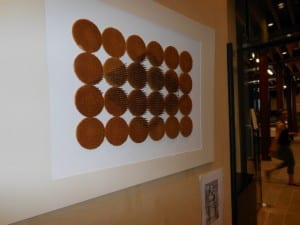Guest post: Central Saint Martins at UCL Art Museum
By Krisztina Lackoi, on 15 August 2012
Guest post by Mary Evans, Central Saint Martins

Artwork inspired by the cross-hatching in Van Dyck’s etchings, (c) Mary Evans installation photograph
In the spring term 2011/2012 a group of second year Fine Art students from Central Saint Martins embarked on a research project at the UCL Art Museum. The project was part of the Expanding Practice unit which is designed to support and broaden students’ approaches to practice and resources for research, production, and reception of works of art. The whole second year cohort across all Fine Art pathways participates in projects in collaboration with other art institutions in London to give students the opportunity to work in new ways and develop new skills. The Guardian Archive, The Petrie Museum, Camden Arts Centre, The Wellcome Collection and UCL Art Museum among others were our collaborators this year.
Curator Andrea Fredericksen expressed what the UCL Art Museum collection had to offer our students thus:
What happens when you have a collection of 10,000 world renowned prints and drawings, dating from the 1490s to the present day, at your fingertips during the development of your artistic practice? Be inspired at UCL Art Museum – home of old master prints by Durer, Van Dyck and Turner as well as innovative works by Slade artists – where you can have hands-on access to this remarkable collection of old and modern treasures. UCL Art Museum invites you to revisit the past masters within their collection to create new work in response; to continue to develop your own practice using contemporary media and contemporary modes of thinking while taking time to consider and appreciate what has gone on before – all in the context of a traditional print room.
On the first day of the project the group was given an informative introduction to the UCL Art Museum collection as well as the Rousseau 300 temporary exhibition. Students came away with knowledge of how the Museum works and how to access the collections. We also went on a tour of the library and to see the impressive Flaxman Gallery. Over the next couple of weeks students visited the collection individually to view some of the material and to start their research.
The project was subsequently delivered through a variety of teaching/learning activities: personal tutorials, group crits and power point presentations. One of the most dynamic sessions was a group seminar with a group of Slade students. Laura Kuch and Phillipa Connolly were instrumental in facilitating this exchange. We met at the UCL Art Museum during Vincula, the 4th Annual Slade/UCL Art Museum collaboration. Some of the exhibiting Slade students discussed the work they had made after interacting with artworks from the UCL Art Museum collections.
The project resulted in three main outcomes.
- with the support and expertise of knowledgeable scholars, archivists and curators, students were introduced to new research methodologies and scholarly protocols whilst being encouraged to appreciate the value of historical objects.
- the project was a valuable peer learning opportunity. The cross pathway and cross institution project enabled students to interact with peers they did not know and were supportive of each other in seminars and group crits. It was interesting for the students to discover what their peers at CSM and the Slade had engaged with in the collection and why and how it differed from their own choices.
- students’ research fed into work which was developed back at the CSM studios in Kings Cross. On the final presentation day in May some of the subsequent work may have seemed to have tenuous links with the original pieces from the collection but in some ways the individual progress made from research to final piece made each students research journey more intriguing and unique.
Some comments from the group:
Visiting the UCL Art Museum was a terrific foundation for my current practice. Having been able to study one of Albrecht Durer’s Master Prints (Knight, Death and the Devil – 1513) on my second visit to the museum I have become a lot more appreciative of the skill involved in creating such work. This inspired me to learn a traditional skill myself.
At the begining of this project, after browsing the amazing UCL’s Art Museum Collection, it is hard to just pick one starting point to work with because there are so many wonderful historical art pieces. I start my project by reading a lots of Jean Jacques Rousseau’s work, that’s my starting point.
Especially for me as a 3D student with less chance to the 2D field, this project raised my knowledge from both the collection itself and the UCL students. The chance of meeting the UCL students was one of the reasons why I had chosen this project. I am interested in the differences of teaching between each art college and how that influences their students.
I was impressed that by the end of the project the group saw the relevance of historical objects and a collection such as that at UCL Art Museum and how they can inform and nurture contemporary practice. There was a willingness to be open to new ways of thinking and a desire to be challenged in their work. It seemed that one of the lasting impressions on the students was the sheer skill displayed in many of the prints and drawings in the collection. I’d like to thank the team at UCL Art Museum for welcoming us and affording us the privilege of interacting with such a beautifully rich resource.
 Close
Close


